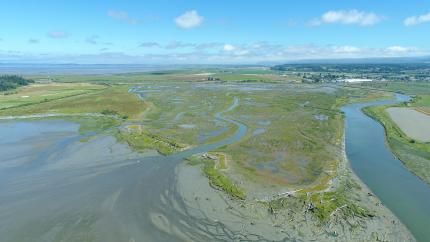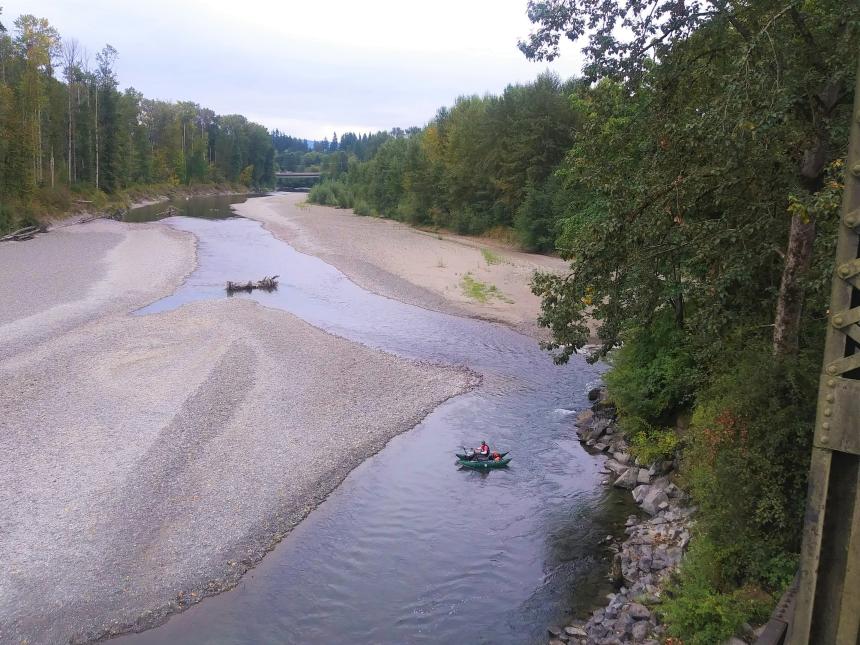Need to report poaching or out-of-season fishing on the Stillaguamish River? Call WDFW Police at 877-933-9847, submit a report online, email reportpoaching@dfw.wa.gov, or call 911 and ask the dispatcher to connect you. Learn more about how to report a violation.
A relatively small river with a huge impact, the Stillaguamish is at the leading edge of salmon declines and habitat conservation concerns in Washington state and across the West Coast.
Endangered Species Act-listed wild Chinook and steelhead runs, a century of habitat loss and degradation, developing communities and changing landscapes all combine in an imperiled ecosystem that is a top priority for the Washington Department of Fish and Wildlife (WDFW), Native American tribes, local governments, agriculture, anglers, conservationists, and many other stakeholders.
Yet there is hope. Today, collaboration is growing to restore this dynamic watershed and its fish runs while supporting local communities, tribes, farms, and fish and wildlife enthusiasts.
Restoring habitat to recover salmon and steelhead in “the Stilly” is a top priority for Washington Department of Fish and Wildlife (WDFW), the Stillaguamish Tribe of Indians, Snohomish County, and other partners. In addition to restoring and reconnecting habitat, WDFW and the Stillaguamish Tribe are partnering on hatchery programs using innovative science and what’s known as “integrated broodstock” to produce Chinook salmon specially adapted for this watershed like their endangered wild cousins.
The importance of this river and its health go beyond us as individuals. Restoration is about the health of community, the ecosystem, and future generations. A better future for the Stillaguamish is possible, but it will take all of us. We must come together across differences for the future of this river. Read more in our August 2023 blog post: Paddling Together; WDFW and Stillaguamish Tribe collaborate to restore habitat and raise Chinook .
Into the Stillaguamish
Originating on the western slopes of the Cascades near the Mountain Loop Highway in eastern Snohomish County and flowing into Port Susan and Puget Sound near the city of Stanwood, the Stillaguamish River—including the North and South forks—is small compared to many other Washington rivers. Yet due to seriously endangered runs of wild Chinook and other fish species, impacts on Stillaguamish salmon play a major role in fisheries management throughout the Puget Sound Region and beyond.
Habitat restoration is a priority for WDFW, the Stillaguamish Tribe of Indians, and many other partners within the watershed. Projects such as restoration of the Stillaguamish estuary at the state’s Leque Island Unit of Skagit Wildlife Area and the tribe’s zis z ba property are returning lands diked and developed by early settlers into functioning intertidal marsh to support juvenile Chinook and other species from waterfowl to bull trout.
Learn more in our video: To the Tides: Restoration at Leque Island and on our Leque Island Restoration Project webpage.

Stillaguamish Integrated Conservation and Rebuilding (SICoR) project
Learn more about SICoR and recent work highlights in our 2022-2023 annual report brochure (PDF).
The number of natural-origin Chinook salmon returning to the Stillaguamish watershed has been declining since the 1980s and has been lower than the critical threshold for species sustainability established by the National Marine Fisheries Service (NMFS) in 2018.
In response, WDFW has dedicated an integrated, focused effort to contribute to the conservation and recovery of Chinook salmon within the Stillaguamish ecosystem, with the creation of the Stillaguamish Integrated Conservation and Rebuilding (SICoR – pronounced “sigh-core”) project.
This cross-program project is a high priority for the Department and for WDFW’s North Puget Sound Region (Region 4).

SICoR Objectives
Per the WDFW SICoR Charter, through an integrated team committed to working together to advance habitat restoration and salmon recovery, SICoR intends to provide clear and consistent understanding of:
- The vision for the Stillaguamish Watershed;
- How habitat, hydropower, harvest, hatcheries, and predators within the ecosystem are affecting Stillaguamish River salmon and steelhead;
- How management actions are contributing to conservation and recovery, and what additional actions are necessary to achieve the expected contribution of each of the above listed sectors.
WDFW is mandated to “preserve, protect, and perpetuate” the fish and wildlife resources of Washington. In response to the decline of Chinook salmon, the Department has dedicated an internal team of experts with an aim to advance salmonid recovery within the watershed, so that the Department can continue to advance fish and wildlife and ecosystem recovery and provide sustainable recreational and commercial fishing opportunities.
The Washington Department of Fish and Wildlife is dedicated to building and maintaining a strong co-management relationship with the Stillaguamish Tribe, The Tulalip Tribes, and other co-managers, as well as understanding how management actions are contributing to conservation and recovery, and what actions are necessary to achieve salmon recovery in the Stillaguamish Watershed.
For more information, please contact Gwendolyn Hannam, Stillaguamish Senior Restoration Specialist and SICoR coordinator, at gwendolyn.hannam@dfw.wa.gov or by calling 425-775-1311.
News and conservation updates
An archive of Stillaguamish news, blogs, and other relevant communications to support awareness. WDFW does not claim ownership of nor endorse all content from other organizations, tribes, or media outlets.
WDFW SICoR reports and updates
Other news and communications
- A new beginning for endangered Chinook, Puget Sound Institute's Salish Sea Currents Magazine, August 2024
- Restoring & conserving a healthy Stillaguamish River Watershed, Stillaguamish Watershed Council, April 2024
- Stillaguamish Tribe to ‘repair, restore’ river with salmon funding, Everett Herald, October 2023
- Efforts throughout area working toward restoration of Stillaguamish Chinook habitat, Skagit Valley News/Stanwood-Camano News, September 2023
- Paddling Together; WDFW and Stillaguamish Tribe collaborate to restore habitat and raise Chinook using innovative broodstock hatchery, WDFW blog, August 2023
- Stillaguamish Tribe begins massive restoration plan for neglected salmon habitat, Q13 Fox News, June 2023
- ‘A delta for the future’: Scientists try to save salmon at Stilly’s mouth, Everett Herald, June 2023
- Federal grant to help support restoration of Similk estuary, Skagit Valley Herald, May 2023
- WDFW moving forward with estuary restoration projects in North Puget Sound, WDFW blog, Feb. 2023
- Into the Stillaguamish: A small Washington river with a big impact, The Daily News, Feb. 2023
- Research continues on pinniped predation in Salish Sea, Skagit Valley Herald, Jan. 2023
- Snohomish County Sustainable Lands Strategy: farmfishflood.org, Dec. 2022
- Stillaguamish River and tributaries to close to all fishing beginning Oct. 1, WDFW news release, Sept. 2022
- Why are seals wearing beanies in Port Susan?, Stillaguamish Tribe of Indians blog, June 2022
- Near Stanwood, thousands of fish discover a restored estuary, The Everett Herald, Feb. 2022
- Hide and seek on the Stillaguamish: How WDFW is working to better understand predation impacts on one of Puget Sound’s most-threatened salmon runs, WDFW blog, Nov. 2021
- Stillaguamish River project underway to help region's chinook salmon, Skagit Valley Herald, Aug. 2021
- Restoring the River: Groups chart complicated path forward for Stillaguamish salmon, Skagit Valley Herald, April 2021
- A tall task: Finding common ground in region’s floodplains, Everett Herald, April 2021
- The Challenges and Strategies for Chinook Recovery: Habitat, Hatcheries & Harvest, Stillaguamish Tribe of Indians blog, March 2021
- Estuary restoration at Leque Island, WDFW blog, Oct. 2019
Stillaguamish outreach and engagement opportunities
A calendar of events and outreach opportunities is available at: wdfw.wa.gov/get-involved/calendar.
For more information on volunteering, please visit our Volunteer opportunities webpage.
